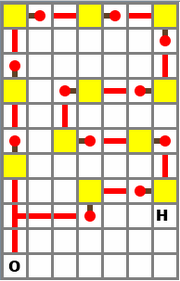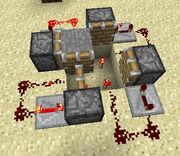이 문서의 일부는 예전 버전의 레드스톤 회로에서 가져왔습니다.
클락 회로는 클락 신호를 생성하는 레드스톤 회로이다. 클락 신호란 반복되는 펄스 패턴이다.
개요[]
클락 생성기 는 출력이 계속 on/off를 반복하는 장치이다. 관례상의 이름인 x-클락은 펄스 길이(펄스 폭)의 반으로부터 유도된다. 예를 들어, 전형적인 5-클록은 출력에 ...11111000001111100000...을 연속으로 생성한다.
레드스톤 횃불과 레드스톤 가루만 사용하면, 최소 4-클락의 클락을 생성할 수 있다. (가끔 문제가 발생할 수 있음) 중계기 또는 피스톤을 사용하면 1-클록까지도 쉽게 만들 수 있으며, 기타 다양한 장치가 존재한다. "래피스 펄서"라는 특별한 회로도 있는데, 1 틱 클록과 같은 빠른 펄스를 생성할 수 있지만, 횃불이 타는 현상(burn out)으로 인해 일관성이 없다. 물론 횃불 기반의 래피드 펄서는 중계기에 사용하기엔 너무 빠르다. 중계기를 사용할 수 이따고 해도, 1-클락 신호는 다른 회로에서는 처리하기 힘들다. 많은 구성요소와 회로가 제때에 반응하지 않기 때문이다.
긴 클락을 생성하는 것(몇 틱 이상)은 더 힘들다. 중계기를 추가하면 결국 거추장스러워지기 때문이다. 하지만, 여러가지 접근 방법이 존재하며, 이는 별도의 절에서 논의한다.
Clocks without an explicit toggle can often have one retrofitted, by wiring a lever or other switch to the controlling block of an inverter, or even to a redstone loop. In general, forcing the delay loop high will eventually stop the clock, but the output may not respond until the current pulse has made its way through the loop. Whether the output will be stopped high or low depends on the clock and where in the loop you force it. Another option is to use a lever-controlled piston to open or close one of those loops, using either a solid block to transmit power, or (as of 1.5) a redstone block to supply it.
While it isn't much discussed in the circuit builds below, there is one extra concept which is occasionally important: Phase. The phase of a running clock is the point it has reached in its cycle. For example, at one moment a 5 clock might be 3 ticks into its ON phase, 4 ticks later, it will be 2 ticks into its OFF phase. A long-period clock might be noted as 2 minutes past the start of its ON phase. The exact beginning of a cycle depends on the clock, but it is usually the start of either the OFF phase or the ON phase. For most cases, phase doesn't matter very much, in that you just need pulses every 7 ticks or whatever. However, in-game computing circuits are more demanding, and if you're doing a daily clock, you surely care whether the ON phase is day or night!
Torch clock[]
Rapid pulsar[]
Schematic Gallery: Rapid Pulsar
Redundancy can be used to maintain a 1-clock, even as the torches burn out; the result is the so-called "Rapid Pulsar" (designs X, Y and (vertical) Z). However, the signal may not be consistent.
Device R creates energy in an irregular sequence. It is a variant of the "Rapid Pulsar" design shown above, except that each torch pulses in an irregular pseudo-random pattern as each torch coming on turns the other three (and itself) off. Occasionally torches will burn out for a few seconds (until reset by a block update), during which time other torches blink. As of version 1.5.1, this is likely to favor one pair of torches, such as the east and west torches, which will blink while the others stay dark. Output can be taken anywhere on the circuit.
Although "pulser" is the correct spelling for any general circuit which produces pulses, the traditional spelling of a clock circuit created from short-circuited redstone torches is "rapid pulsar".
Torch loop[]
The basic torch pulser is the oldest clock circuit in Minecraft, simply an odd number of inverters (NOT gates) joined in a loop. The design has been mostly replaced by repeaters, but still works. Design A shows a 5-clock, which is the shortest clock that can easily be made this way. Its pulse length can be extended by adding pairs of torches and/or repeaters. Repeaters can be added into the loop, or can replace any pair of inverters. Adding repeaters also allows even-numbered clocks such as a 10-clock. The total interval will be "NOT gate count"+"repeater total delay".
Vertical Torch 5-clock (G)
Compact Torch Loops
Even torch based 5-clocks can be made more compact, as with designs B and C. However, these have fewer places where repeaters can be inserted without using more space. Using this method, 1-clocks and 3-clocks are possible, but these will be unstable and erratic as the torches will regularly "burn out". As with the basic clock, the compact clocks can be extended by making the chain of inverters longer, or with repeaters. A 5-clock can also be made vertical, as in G
Torch 4-clocks
Design D uses a different method to produce a 4-clock. (A 4-clock is the fastest clock of this sort which will not overload the torches.)
Design E may be obsolete as of version 1.7. By making use of the North/South Quirk, it was possible to produce a more compact 4-clock with a regular on/off pulse width, as seen in design E. This design uses five torches, but if the stacked torches are pointed north-south, it has a pulse width of 4 ticks.
Repeater clock[]
A clock signal can be generated by introducing a pulse into a loop of repeaters.
- Repeater Loop 1-Clock
Repeater Loop 1-Clock – The torch and block of redstone can be removed after the clock is running.
- 2×3×2 (12 block volume)
- flat, silent
- clock output: 1 tick on, 1 tick off
- The simplest repeater clock is simply two repeaters connected with redstone dust in a loop.
- The tricky part is introducing a 1-tick pulse into the loop. If the pulse is too long, the repeaters will both be permanently powered and the only way to fix it will be to break and then fix the circuit.
- A simple solution to this is to use a lever; flipping it on and then off 1 tick later. The most common method seems to be to place a redstone torch next to the clock, then quickly break it. This may take several attempts to do correctly, requiring the clock be broken and fixed between attempts. A more reliable method (shown right) is to place the torch on a powered block (a block of redstone, or any block powered by another torch or other power source) – the torch will be on when placed, but will turn off 1 tick later because it's attached to a powered block. The torch and powered block can then be removed, but stopping the clock later will still require breaking it.
- Variations: The dust in front of the repeaters can be replaced with blocks to save on redstone.
- Additional repeaters can be added to the loop, increasing the clock period. As long as all the repeaters are kept to a 1-tick delay, the pulse will remain only 1 tick long no matter how many repeaters are added. If the delay is increased on any of the repeaters, the pulse length will increase to match the longest repeater delay.
- Switchable Repeater Loop 1-Clock
Switchable Repeater Loop 1-Clock – The piston is sticky.
- 3×4×2 (24 block volume)
- flat, silent (while running)
- clock output: 1 tick on, 1 tick off
- This repeater loop can be switched on and off, by moving a block to complete or break the circuit loop.
- How it works: When the lever turns on (t = 0 redstone ticks), the sticky piston begins to extend. At t=1, the torch turns off, but the left repeater stays powered for 1 more tick. At t=1.5, the piston finishes extending and the moved block gets powered by the left repeater. At t=2, the left repeater turns off. At t=2.5, the right repeater begins to output the power passed to it by the block. From here on, it just continues as a 1-clock until the lever is turned off, instantly breaking the loop.
- Repeater Loop 10 Hz Clock
Repeater Loop 10 Hz Clock
- 3×4×2 (24 block volume)
- flat, silent
- clock output: 1 tick on, 0 ticks off
- This clock produces a 10 Hz clock signal (10 activations per second) consisting of 1-tick on-pulses separated by 0-tick off-pulses (the off-pulse exists, but it is replaced by an on-pulse in the same game tick).
- Start the clock with a 1-tick pulse (for example, by placing a torch on a powered block). Stop the clock by breaking a piece of redstone dust. Alternatively, the switchable method described above may be used.
- A 10 Hz clock runs too fast for some redstone components to respond to. Command blocks and note blocks can handle the rapid activation. Doors, trapdoors, and fence gates will produce sounds as if being activated and deactivated that quickly, but will appear and act as if constantly activated. Pistons will act as if constantly activated, but the 0-tick off-pulses will produce the flickering appearance of a deactivated piston overlapping the activated piston. Other redstone components will simply act as if constantly powered.
클락 회로[]
클락 생성기[]
클락 생성기와 펄서.

클락 생성기의 예시.

11클락 생성기의 예시
클락 생성기는는 출력이 껐다 켜짐을 계속 반복하는 장치이다. 가장 간단한 안정된 클락 생성기는 5클락 생성기이다. (디자인 B 와 C). 이 방법을 사용해서, 1클락과 3클락도 가능하지만 속도 때문에 토치를 태울 수 있어서 불안정하다. 토치를 여러개 놓는 것은 1클락 생성기를 토치가 꺼져도 유지시킬 수 있다; 그 결과물이 "래피드 펄서"이다 (디자인 A 와 F). 느린 클락은 인버터를 더 길게 해서 만들 수 있다. (디자인 B' 와 C' ).
다른 방법으로, 4클락을 만들 수 있다 (디자인 D). 4클락은 더 빠르면서도 토치를 꺼뜨리지 않는다.
4클락 리피터와 규칙적인 켜짐/꺼짐 펄스 너비는 디자인 E 처럼 가능하다. 이 디자인은 다섯 개의 토치를 사용한다, 그러나 북향/남향 버그를 사용해서 4틱 너비로 만들 수 있다. 이 디자인은 북쪽/남쪽 방향성이 중요하다. (혹은 최소한 일부분이라도 쌓여 있는 토치를 포함해야 한다)
"n"클락의 이름은 보통 펄스의 너비로 지어진다. 예를 들어,B 디자인 (5클락) 은 ...11111000001111100000... 의 신호를 출력한다.
F 와 G 디자인은 가능한 수직 배치이다.
H 디자인은 11클락의 디자인이다. 5클락보다 약 50% 더 느리다.
리피터 클락[]

레드스톤 리피터를 사용하는 조정 가능한 클락 생성기. 딜레이는 더 많은 리피터를 붙여서 거의 무한하게 늘릴 수 있다.

4리피터 클락의 예시
베타 1.3 업데이트의 레드스톤 리피터의 추가로, 클락 생성기는 한 개의 레드스톤 토치와 아무 개수의 리피터를 서로 연결해서 약 한 개의 블록까지 단순화할 수 있게 되었다.
짝수의 펄스 너비를 가진 매우 빠른 클락은 레드스톤 리피터로만 만들 수 있다. 각각의 리피터의 딜레이와 리피터의 개수를 추가해서 클락은 더 느려질 수 있다. 이러한 클락은 가변적인 클락을 가진다, 그러나 더 높은 최고속도를 가진다.
피스톤 클락[]

피스톤 클락의 예시.
베타 1.7 업데이트에 추가되면서, 피스톤으로 펄스 생성기 없이 펄스 딜레이를 변경할 수 있는 새로운 종류의 클락 생성기를 만들 수 있다. 이것은 다른 피스톤이 더 복잡하고 빠른 피스톤 기계장치의 생성을 용이하게 해서 어느 정도 클락되게 한다.


